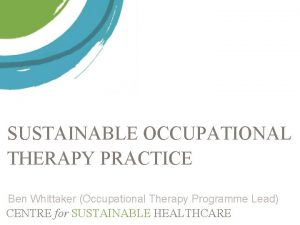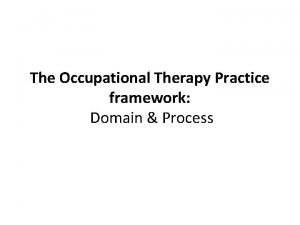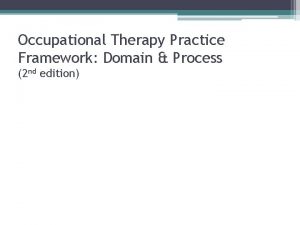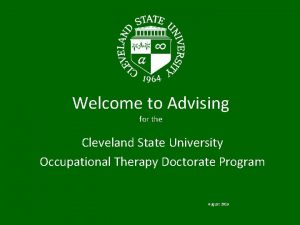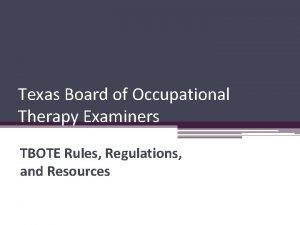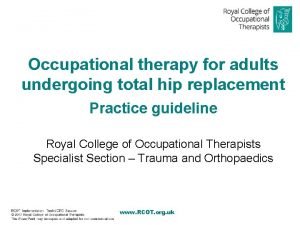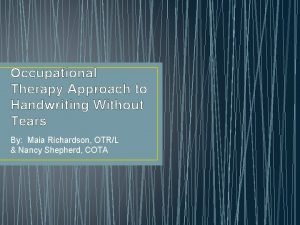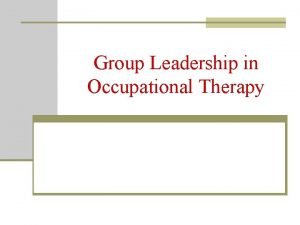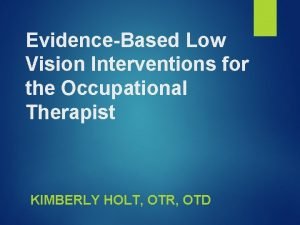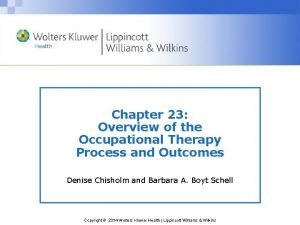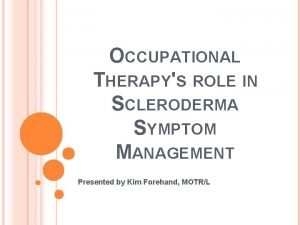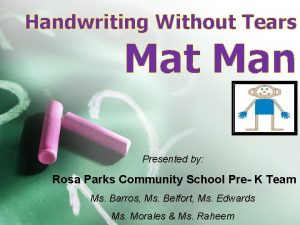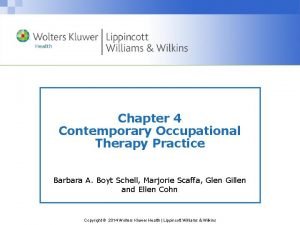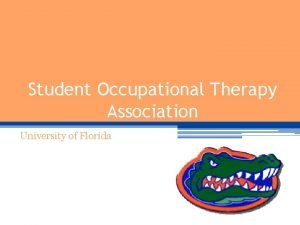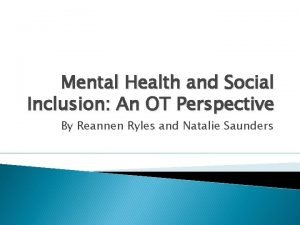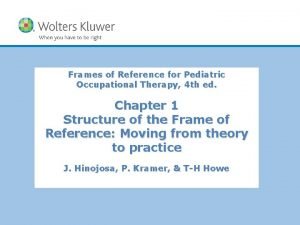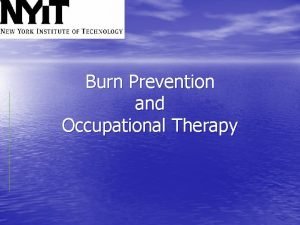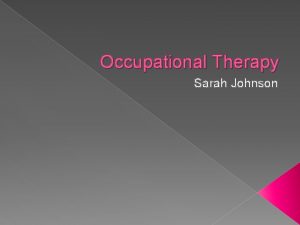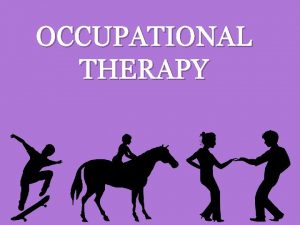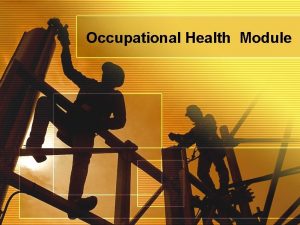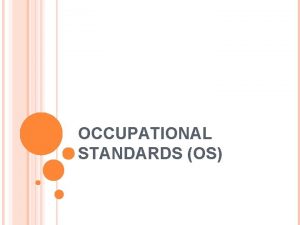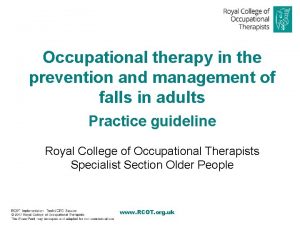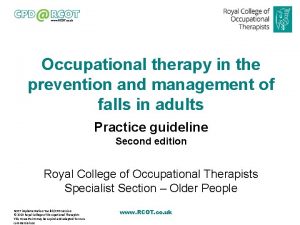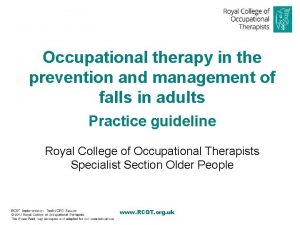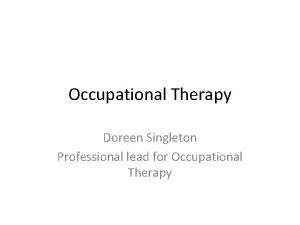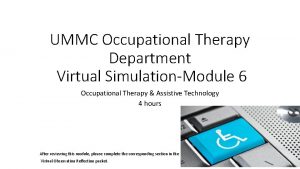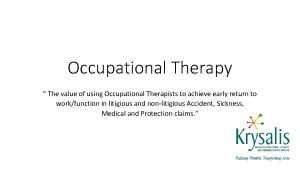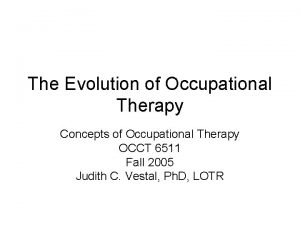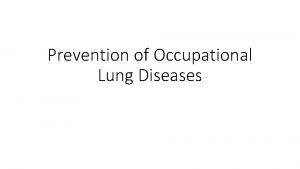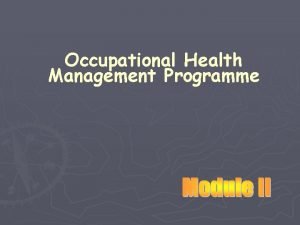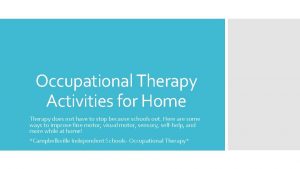Occupational therapy in the prevention and management of
























- Slides: 24

Occupational therapy in the prevention and management of falls in adults Practice guideline Royal College of Occupational Therapists Specialist Section Older People www. RCOT. org. uk

Learning outcomes • To explore aspects of the practice guideline recommendations in relation to current practice. • To develop an understanding of the importance of using practice guidelines to inform practice. • To explore and develop an understanding of how to use the RCOT Audit Form for use with the evidence-based recommendations. www. RCOT. org. uk 2

Practice question: What evidence is there to support occupational therapy in the prevention and management of falls in adults? www. RCOT. org. uk 3

Key objective of guideline To provide evidence-based recommendations that inform occupational therapists, working with adults, of their role within the multifactorial assessment and intervention required to prevent and manage falls. It addresses occupational therapy intervention at any point during a service user’s journey along the falls care pathway. www. RCOT. org. uk 4

Methodology 1. Guideline development group established 4. Screen findings 5. Critically appraise articles 6. Development of practice guideline recommendations 9. Published by COT 2015 2. Guideline scope defined involving stakeholders 3. Literature search 7. Peer review, stakeholder and service user consultation 8. Final draft approved by COT Practice Publications Group www. RCOT. org. uk 5

Evidence-based recommendations Recommendations are based on the evidence available within 33 critically appraised papers. Each recommendation is assigned: • A strength scoring 1 or 2 (Strong or Conditional) • A quality grading A, B, C or D (High, Moderate, Low or Very Low) www. RCOT. org. uk 6

Recommendation areas 1. Keeping safe at home: reducing risk of falls 2. Keeping active: reducing fear of falling 3. Falls management: making it meaningful www. RCOT. org. uk 7

Keeping safe at home: reducing risk of falls Evidence overview: ‘The evidence with respect to the effectiveness of the occupational therapist in home hazard assessments and interventions for people considered at high risk of falls (history of falling in past year, hospitalisation for a fall, severe visual impairment or functional decline) is both high quality and strong’ (COT 2015, p 37). www. RCOT. org. uk 8

Keeping safe at home: reducing risk of falls It is recommended that: 1. Service users who have fallen or are at risk of falls should be offered an 1 A occupational therapist-led home hazard assessment, including intervention and follow-up, to optimise functional activity and safety. (Campbell et al 2005 [A]; Clemson et al 2008 [A]; Clemson et al 2004 [A]; Costello and Edlestein 2008 [B]; Gillespie et al 2012 [A]; La Grow et al 2006 [A]; Nikolaus and Bach 2003 [A]; Pighills et al 2011 [A]) 2. Occupational therapists should offer home safety assessment and modification for older people with a visual impairment. 1 A (Campbell et al 2005 [A]; Clemson et al 2008 [A]; Gillespie et al 2012 [A]; La Grow et al 2006 [A]) www. RCOT. org. uk 9

Keeping safe at home: reducing risk of falls It is recommended that: 3. Occupational therapists should consider carrying out a pre- or post 1 B discharge home assessment to reduce the risk of falls following discharge from an inpatient rehabilitation facility, taking into account the service user’s falls risk, functional ability and diagnosis. (Di Monaco et al 2012 [B]; Di Monaco et al 2008 [B]; Johnston et al 2010 [C]) 4. Occupational therapists should offer service users who are living in the community advice, instruction and information on assistive devices as part of a home hazard assessment. 1 B (Steultjens et al 2004 [B]) www. RCOT. org. uk 10

Keeping active: reducing fear of falling Evidence overview: ‘The evidence on fear of falling highlights the integral link between fear and activity levels. Although reducing the number of falls may be a key outcome for falls prevention activities, the potential to restrict activity as a behavioural response to fear of falling can be to the detriment of activities of daily living and occupational engagement. People have different attitudes and levels of tolerance to risk. The occupational therapist therefore has a valuable role in working with service users, caregivers, family and friends to achieve a balance of risk and activity’ (COT 2015, p 42). www. RCOT. org. uk 11

Keeping active: reducing fear of falling It is recommended that: 5. Occupational therapists should explore with service users whether fear 1 C of falling may be restricting activity, both in and outside the home, and include the promotion of occupational activity within individualised intervention plans. (Boltz et al 2013 [C]; Kempen et al 2009 [C]; Painter et al 2012 [C]; Wijlhuizen et al 2007 [C]) 6. Occupational therapists should listen to an individual’s subjective views 1 B about their falls risk, alongside using objective functionally based outcomes, to determine the influence of fear of falling on the service user’s daily life. (Schepens et al 2012 [B]; Wijlhuzen et al 2007 [C]) www. RCOT. org. uk 12

Keeping active: reducing fear of falling It is recommended that: 7. Occupational therapists should seek ways of enabling service users to 1 B minimise the risk of falling when performing chosen activities, wherever possible, as this may improve confidence and enable realistic risk taking. (Wijlhuzen et al 2007 [C]; Zijlstra et al 2007 [B]) 8. Occupational therapists should facilitate caregivers, family and friends to adopt a positive approach to risk. (Boltz et al 2013 [C]) www. RCOT. org. uk 1 C 13

Falls management: making it meaningful Evidence overview: Occupational therapists should maximise the engagement of the service user in falls management interventions, taking into consideration the service user’s motivation, beliefs and knowledge. A key message to be incorporated into falls prevention and management interventions is a focus on the potential benefits to the individual of interventions to improve mobility, independence and active participation, as distinct to the language used within the professional arena of ‘reducing the incidence of falls’ or ‘decreasing the risk of falls’. Service users should be made aware of the potential implications of falling, but occupational therapists should highlight the positive outcomes rather than the negative connotations associated with falls. Contd: www. RCOT. org. uk 14

Falls management: making it meaningful Evidence overview contd: Meaningful activity can be integrally linked with motivation. Physical activity which can be incorporated into daily lifestyles is more likely to be sustainable; there is a key role here for occupational therapists given this functional approach. The value of such an occupational and activity-based approach is supported by the high-quality research by Clemson and colleagues. Although the primary research for the Li. FE approach was undertaken in Australia (Clemson et al 2012, Clemson et al 2010), potentially it is easily translatable to the United Kingdom (COT 2015, p 48). www. RCOT. org. uk 15

Falls management: making it meaningful It is recommended that: 9. Occupational therapists should share knowledge and understanding of 1 B falls prevention and management strategies with the service user. This should provide personally relevant information and take account of the service user’s individual fall risk factors, their lifestyle and preferences. (Ballinger and Clemson 2006 [C]; de Groot and Fagerström 2011 [C]; Haines et al 2006 [C]; Haines et al 2004 [B]; Stern and Jayasekara 2009 [B]) 10. Occupational therapists should take into account the service user’s 1 C perceptions and beliefs regarding their ability, and personal motivation, which may influence participation in falls intervention. (de Groot and Fagerström 2011 [C]; Gopaul and Connelly 2012 [D]; Nyman 2011 [C]) www. RCOT. org. uk 16

Falls management: making it meaningful It is recommended that: 11. Occupational therapists should maximise the extent to which the service user feels in control of the falls intervention. 1 C (Currin et al 2012 [C]; Wilkins et al 2003 [C]) 12. Occupational therapists should support the engagement of the service user 1 C in identifying the positive benefits of falls intervention. (Ballinger and Clemson 2006 [C]; Nyman 2011 [C]) 13. Falls prevention and management information should be available in different formats and languages to empower and engage all populations (e. g. web-based support, written information leaflets). 1 B (Hill et al 2009 [B]; Nyman et al 2011 [C]) www. RCOT. org. uk 17

Falls management: making it meaningful It is recommended that: 14. Physical and social activity, as a means of reducing an individual’s risk of falls and their adverse consequences, should be encouraged and supported through the use of activities meaningful to the individual. 1 B (Rosendahl et al 2008 [B]) 15. Activities to improve strength and balance should be incorporated into daily activities and occupations that are meaningful to the individual, to improve and encourage longer term participation in falls prevention interventions. 1 A (Clemson et al 2012 [A]; Clemson et al 2010 [B]; Pritchard et al 2013 [B]) www. RCOT. org. uk 18

Impact of practice guideline for you: the practitioner • Challenges / affirms your current practice. • Informs your practice. • Provides evidence to support your practice (completion of Audit Form). • Provides a vehicle for you to justify your practice. www. RCOT. org. uk 19

Impact of practice guideline for managers • Provides evidence of the need for occupational therapy input into services for adults who fall, are at risk of falling or are fearful of falling. • Provides a structure to audit the work of occupational therapists within the service to improve service quality. • Provides a vehicle for justifying service provision. www. RCOT. org. uk 20

Impact of practice guideline for commissioners • Articulates the need for occupational therapy interventions within services for adults who fall, are at risk of falling or are fearful of falling. • Provides recommendations developed by a NICE Accredited process. • Can help educate commissioners to identify learning needs for the workforce. • Audit form provides a mechanism to review service delivery in accordance with the evidence. www. RCOT. org. uk 21

Impact of practice guideline for service users • The recommendations reinforce the fundamental importance of the service user perspective • In being adopted by services and occupational therapists, the guideline should improve the consistency and quality of intervention for users of services. • Gives assurance that practitioners use the available evidence to support interventions. www. RCOT. org. uk 22

Service user perspectives “I had a fall on my front path and landed heavily on my knee. I have had a loss of confidence after my fall – although equipment helps, it does not restore your confidence” “People are all different – how they express this [risk of falls] will also be different – some will need encouragement to do more, others may need holding back a bit” “When I was really unwell I had over ten falls a day. This was often terrifying. I felt disabled and scared of injury. I had many cuts and bruises and was embarrassed to be in public so stopped at home, unable to work or socialise” “The problem with the term risk assessment is it implies all risks are the same, and they aren’t” 23

Practice guideline resources • College of Occupational Therapists (2015) Occupational therapy in the prevention and management of falls in adults: practice guideline. London: COT. • Audit tool • Quick Reference Guide • Feedback form Resources are available from the Royal College’s website at: https: //www. rcot. co. uk/practice-resources/rcot-practice -guidelines www. RCOT. org. uk 24
 Primary prevention secondary prevention tertiary prevention
Primary prevention secondary prevention tertiary prevention Fall prevention occupational therapy
Fall prevention occupational therapy Bioness integrated therapy system price
Bioness integrated therapy system price Occupational therapy and environmental sustainability
Occupational therapy and environmental sustainability Domains of occupational therapy
Domains of occupational therapy Occupational therapy practice framework domain and process
Occupational therapy practice framework domain and process Csu otd
Csu otd Peo framework occupational therapy
Peo framework occupational therapy Alert program occupational therapy
Alert program occupational therapy Tbote license renewal
Tbote license renewal Backward chaining occupational therapy
Backward chaining occupational therapy Occupational therapy intervention plan for hip arthroplasty
Occupational therapy intervention plan for hip arthroplasty Handwriting without tears occupational therapy
Handwriting without tears occupational therapy Leadership in occupational therapy
Leadership in occupational therapy Occupational therapy assessments for low vision
Occupational therapy assessments for low vision The ot process
The ot process Occupational therapy day
Occupational therapy day Scleroderma occupational therapy
Scleroderma occupational therapy Mat man activities
Mat man activities Boley gauge occupational therapy
Boley gauge occupational therapy Contemporary occupational therapy practice
Contemporary occupational therapy practice Ummc occupational therapy
Ummc occupational therapy Florida occupational therapy association
Florida occupational therapy association Peo ot
Peo ot Pediatric occupational therapy frames of reference
Pediatric occupational therapy frames of reference



